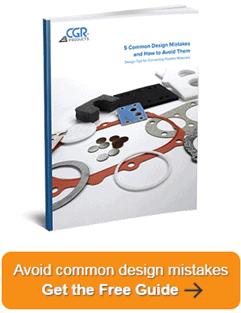More cutting methods are available today than ever before. While friction sawing used to be the primary industrial material cutting option, there are now nearly a dozen viable choices.
Not all cutting methods are created equal — which isn’t to say that one is categorically better than another, but rather that they all have their own strengths. To ensure the accuracy, efficiency, and cost effectiveness of your next project, each designated cutting method specified for a particular part should be a major consideration starting in the design phase.
Two of the more common cutting methods that manufacturers offer today, die cutting and waterjet cutting, each have benefits that are suited to particular needs.
Waterjet Cutting
Waterjet cutting, exactly as its name implies, uses highly pressurized jets of water to cut through soft materials. When harder materials such as metals or plastics are needed, abrasive mineral can be added to the water to enable the waterjet to cut these materials as well. This method offers several benefits over die cutting and other cutting methods.
Clean Cuts
Primary among these benefits are the clean cuts that the process generates.
Many companies consider waterjet cuts to be “finish cuts,” aesthetically acceptable cuts that require no secondary finishing processes. This is important for applications where financial budgets or time constraints are a concern — finishing processes add both time and money to your project.
Low Heat
The second important benefit of waterjet cutting is that it generates little heat, and transfers even less to the material being cut. This is important for a number of reasons:
- It allows for the use of waterjet cutting on meltable and flammable materials — such as plastics, laminates, acrylics, and more — that can’t be laser or plasma cut
- It prevents the release of heat-generated toxins into the workplace
- It doesn’t create heat affected zones on cut parts, thereby eliminating a secondary finishing process that laser or plasma cut parts often require
Tolerances
Waterjet cutters are able to maintain tighter tolerances in their cuts because the cutters are controlled by highly accurate computer software. Additionally, the process creates no mechanical stresses in the material being cut, eliminating the loss of tolerance caused by warping.
Die Cutting
Die cutting is a very common method of cutting, wherein sheets of material are stamped with a die in order to create the required part. Die cutting carries many benefits:
Speed
Most die cutting processes, including rotary die cutting and progressive die stamping, are continuous processes. In these processes, rolls of material are continually fed into the equipment and stamped parts are continually output.
Simple parts in particular can be produced at great rates. Simple flat cogs, as an example, can be completed in one second with a single stamp. More complicated parts can be quickly manufactured by utilizing a progressive die stamping process.
Uniformity
Particularly important for large volumes of identical components, die cutting creates parts with a high degree of uniformity. Punching a part out with one swift movement prevents variances that can occur in processes that cut a shape around the edges. Tool and die fatigue can occur, but a quality stamper will know his machines and replace affected equipment long before they can impact the quality of the parts.
Cost
Because of its ability to create very high volumes of parts with a high degree of uniformity, die cutting is a relatively inexpensive method of cutting. The high output reduces time and, therefore, labor costs, and uniform products reduce losses related to quality assurance.
Additionally, die cutting equipment is fairly standard — many companies perform die cutting, so competition keeps costs reasonable. Tool and die manufacturing can be costly, but high volume part orders can easily negate that one-time expense.
Cutting with CGR
Over the course of more than 50 years, CGR Products has developed expertise with a range of different cutting methods — not only die and waterjet cutting, but also knife cuttingand more. Not every method is the same, nor are they all suitable for any project.
To learn more about cutting methods and other important design considerations, download our eBook, 5 Common Design Mistakes & How to Avoid Them.



